Looking for a good time tracker to help you keep track of your work? Always struggling to figure out how long you’re spending on a particular task? You’ve probably seen plenty of ads for Toggl Track time tracker. If you’re here, then you’re wondering: is Toggl any good? That’s the question we’re going to answer in this in-depth Toggl review.
Boost your team’s efficiency with Hubstaff's productivity tools
What is Toggl Track?
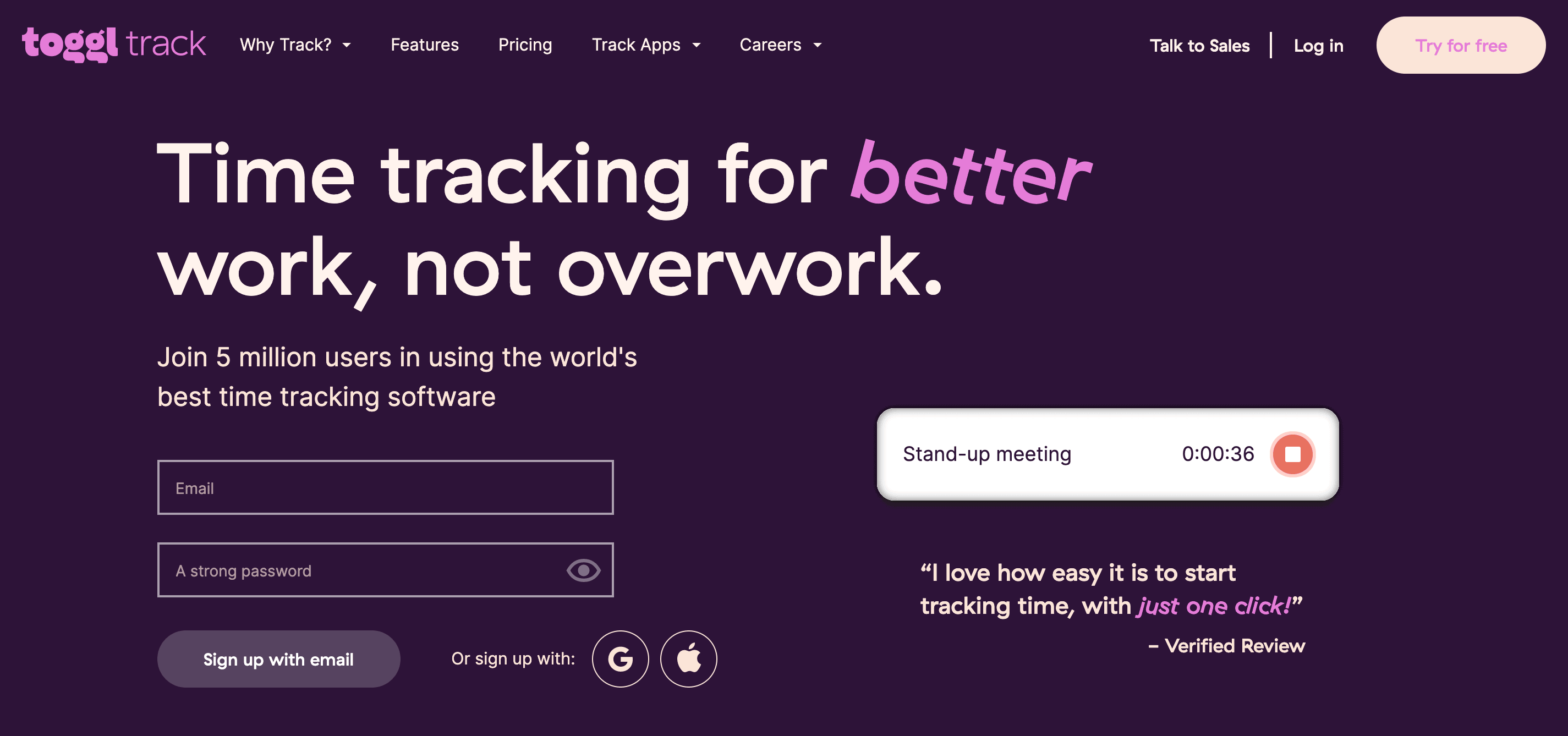
Toggl Track is an automated time tracking software that helps freelancers, consultants, and remote teams keep track of their billable hours.
At its core, Toggl Track is a basic start-and-stop timer that helps you track your working hours. All plans include idle detection that helps keep your records clean, a built-in Pomodoro timer for productivity, and reporting features that allow you to analyze your data and use your time more efficiently.
You can track across devices, record hours by project, and use the mobile app and the Toggl Track desktop app to complete the job — time will sync automatically. Basic time tracking in the free version is a great starting point for individuals and small teams.
Paid plans include more features. If you want to track billable rates or manage time for your entire team, you’ll need an upgraded plan to do it. For enterprise-level businesses, Toggl Track can build tailored plans with custom pricing.
Regardless of your plan, Toggl Track is best for automating time tracking at a basic level. It’s designed for freelancers and teams that want a reliable way to start tracking time but don’t want to track other productivity metrics closely.

Who is Toggl Track for?
Toggl Track has options for freelancers, small teams, and large teams, but their options for teams look different than other tools for tracking time. Their plans make more sense when you consider their history.
The story of Toggl begins with an Estonian software consultancy looking to log billable hours and provide more transparency to their clients. To solve this issue, they created the time tracking solution we now know as Toggl Track. The team planned to keep the software in-house, but one client loved it so much they wanted to pay for it. The rest is history.
Today, Toggl still operates from this perspective. While other time tracking tools put large companies first, Toggl Track identifies most strongly with the consultants, freelancers, and independent contractors they once were. They make this clear in their anti-surveillance policy. In the policy, Toggl vows never to implement proof of work features. Their goal is to protect the privacy of individuals above all else.
This is a great relief for anyone who has ever worked under a micromanager. This policy also helps independent contractors distinguish between reasonable proof of work and constant demands for updates from overbearing clients. However, there’s a reason that those more robust tracking features exist, and it’s not because managers are insecure. You might need more visibility in your remote team, and Toggl Track won’t provide it.
Let’s look at some other pros and cons of Toggl Track.
Toggl Track pros and cons
| Pros | Cons |
|---|---|
| Easy to use | Lacks proof of work and activity features |
| Extensive list of integrations | No invoicing |
| Time tracking reminders | No scheduling |
| Reports | Non-intuitive UI |
| Free plan with all the basic features | Expensive paid plans considering features |
You get reporting, planning, and analysis tools with the paid plans. However, since Toggl Track is hyper-focused on time tracking, all the features not directly related to time tracking are less robust than offerings from other competitors.
As a tool built for freelancers and agencies, it’s surprising that there are no built-in tools for invoicing. Toggl Track also lacks the scheduling and team management features that other time trackers offer with upgraded plans. Some users have expressed difficulty switching projects and correcting time. Others point out that there’s no pause feature — Toggl Track creates a new session each time you stop and restart the timer, so taking a break may make it look like you switched tasks.
Overall, lots of people love Toggl Track and find it to be a handy tool. It’s not the best fit for all teams, but this is a solid choice if you’re looking for simple time tracking.
Let’s take a closer look at some of the specific features of Toggl Track.
User interface and experience
The Toggl Track interface is straightforward to use. At its core, this app is just a start-and-stop timer, so it should be simple and intuitive. The design and interface are great for solo users and small teams. Most users find it equally pleasant to track time using a browser extension, mobile app, or desktop application. Even when switching devices, the different versions of the app sync up. If you start a timer on a mobile device while the desktop timer is running, Toggl Track will recognize this and sync multiple devices.
When you start adding team members, though, the user experience could be better. Time tracking within a team can get complicated, and some organizations find that team members simply don’t track time at all.
It makes sense that the Toggl Track interface works better for individuals and very small teams since that’s their primary focus. Larger teams can make it work, but finding what works for you may involve a learning curve.
Subscribe to the Hubstaff blog for more time tracking tips
Managing team members and projects
When it comes to team management, Toggl Track meets basic needs but falls a little short of the other time tracking options on the market. It offers a few useful features to help you keep your team organized, though. You can set reminders, send email alerts about project deadlines, and see your team’s bandwidth from one convenient dashboard. Even on the free version, you can create multiple projects without limits. You’ll need an upgrade if you want to develop sub-tasks within those projects for time tracking.
If you’re looking for productivity data or proof of work features, Toggl Track isn’t your best choice. Since this tool doesn’t capture any productivity metrics, you can miss some of the critical early signs of problems in your workflow. Some users also point out that they’d like scheduling tools within the software to make decisions about shifts and coverage based on tracked time and deadlines.
Payroll and invoicing
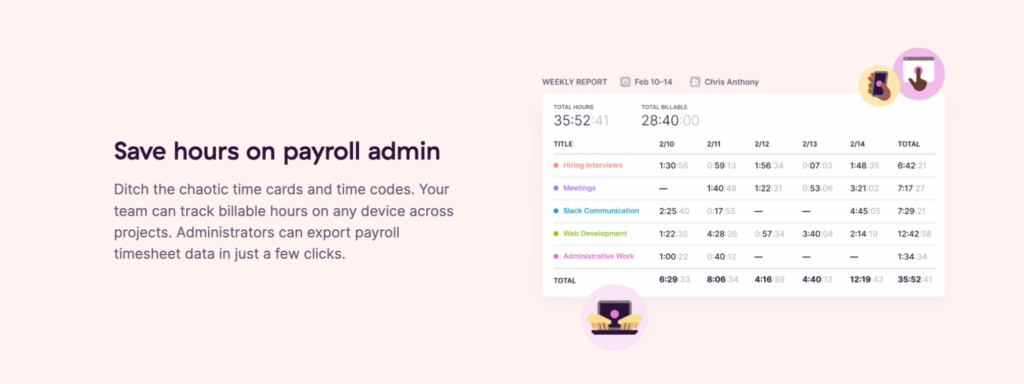
The time your team tracks in Toggl Track can be handy to help you fill out timesheets for payroll. You’ll have to do it manually or use an integration, but that tracked time is more accurate and reliable than regularly submitted timesheets.
If you work with clients and bill by the hour, Toggl Track’s Starter plan or higher is also a reliable way to keep track of your billable hours. You can use that tracked time to help you create invoices from actual time entry data, though billing clients is manual. There is no built-in invoicing tool.
Users have expressed frustration with this issue:
Timothy T., Computer software (Source: GetApp)
Carlin R., Information Technology and Services (Source: GetApp)
Amy H., Design
Reporting
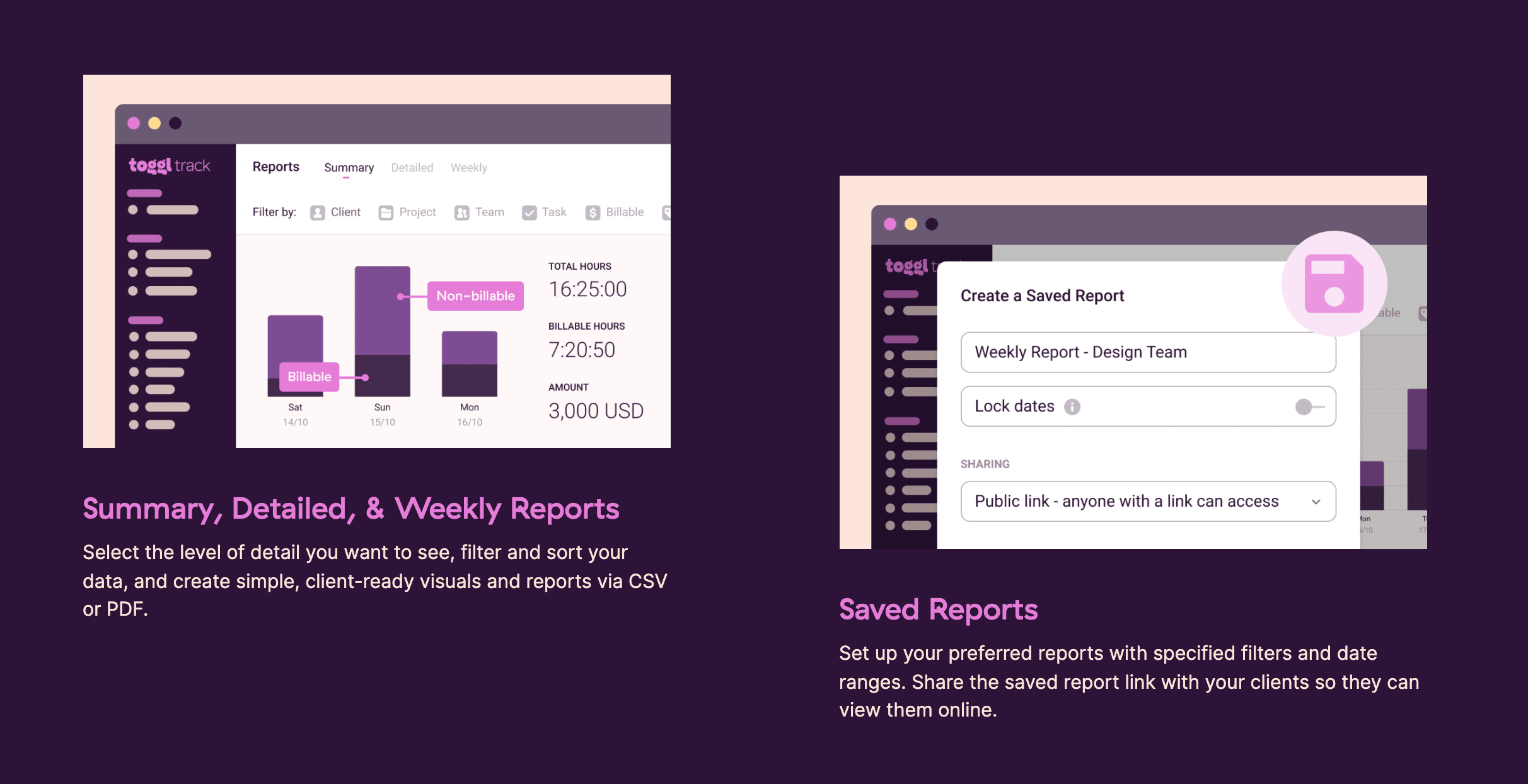
Tracking time is great, but you might as well use a stopwatch unless you can draw insights from the time you’ve tracked. Reporting makes all the difference.
Summary reports show tracked time broken down in different ways. You can see how much time was tracked to various projects or how many hours your team logged on a specific day. Detailed reports are a more in-depth look at tracked time. You can edit time entries in the detailed reports in Toggl Track. Remember that you can only add time for your team members with a Premium plan subscription. Weekly reports are a basic summary of the time your team tracked each week. These saved reports can be exported as a PDF or CSV file, which is useful if you use Toggl Track data to complete timesheets.
Reports in Toggl Track are intuitive and straightforward. You can easily look at different date ranges, projects, or team members to see time tracking data. Paid tiers offer more functionality. At the Starter level, you can save reports so they’re easy to find. Premium and Enterprise members can schedule reports via email.
There are some limitations to reporting in Toggl Track because the software only gathers time tracking data. There’s no way to gauge productivity or confirm that your team members tracked time to the correct projects.
For freelancers and most small teams, the simplicity of Toggl Track’s reporting is only a minor annoyance at worst. In fact, some teams prefer less information because they see what they want to find faster. Teams that need more visibility around their time tracking should consider one of a few similar services that include more robust time audits.
Get more advanced features with Hubstaff reporting
Review your team’s activity, expenses, and project budgets in one accessible dashboard.
Toggl Track integrations
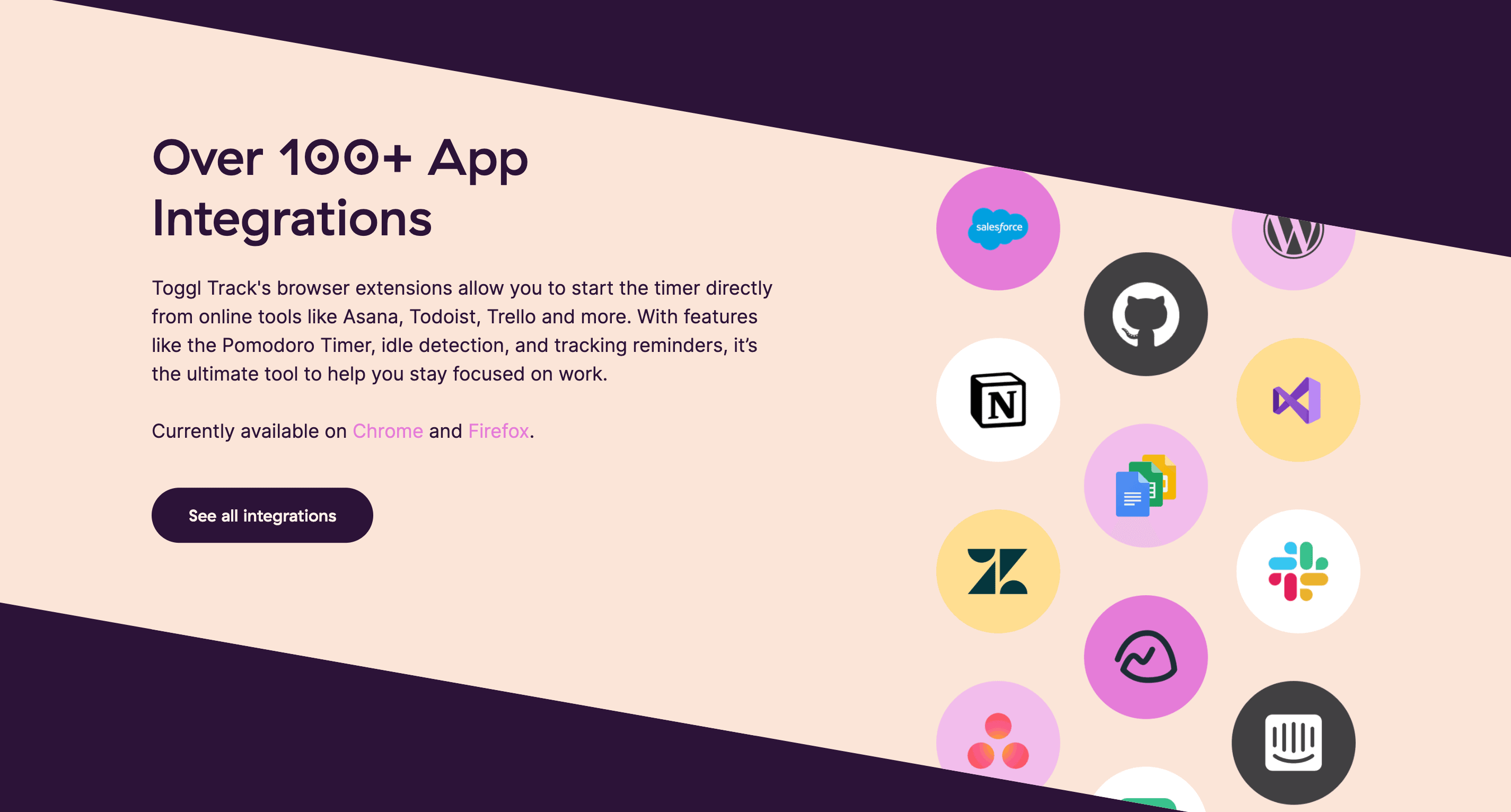
Toggl Track currently offers over 100 integrations for apps like Asana, Todoist, Slack, Trello, and Salesforce. When you use these integrations, Toggl Track becomes a more powerful tool for:
Project management software
- Asana
- Trello
- Jira
- Notion
- Toggl Plan
HR & accounting
- Xero
- Spidergap
- Zoho Books
Help desk & customer support
- Salesforce
- Freshdesk
- Zendesk
Integrations are a smart way to get more functionality for Toggl Track. Plus, some of the native integrations put a timer button directly into the tools you use every day, such as Jira and Salesforce. An API can make connecting your tool to Toggl Track possible. For example, you might want to connect your internal task management software to import tasks automatically.
Overall, Toggl Track’s list of integrations gives you more flexibility and convenience.
Toggl Track pricing
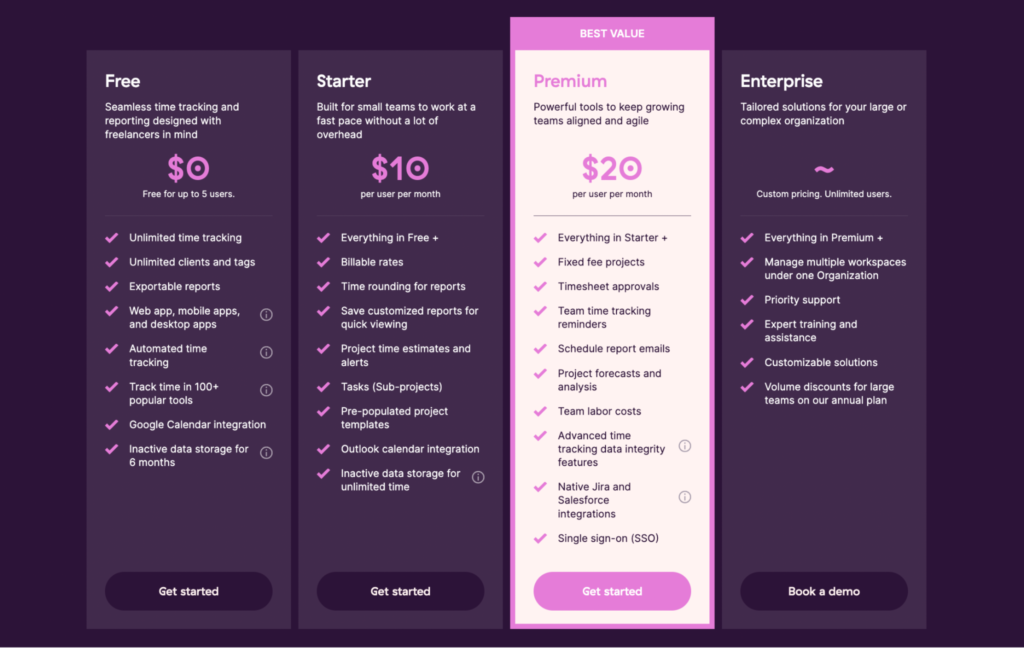
If you’re managing a small team with no more than five people, you can’t beat the pricing for the basic Toggl Track plan — it’s free. You’ll get an offline tracking mode and the ability to support unlimited company projects and clients. Choosing Toggl Track paid plans is a little expensive, considering the features.
At $10 per user per month, the Starter plan offers fewer features and fewer team management capabilities than other time trackers at the same price point. Toggl Track provides the most helpful team management features in their Premium plan, which is $20 per user per month. That price adds up quickly as your team grows, and each person needs a user account.
| Plan | Price |
|---|---|
| Free | $0 |
| Starter | $10 per user/month |
| Premium | $20 per user/month |
Looking for a Toggl Track alternative? Track time with Hubstaff
Hubstaff is an excellent alternative to Toggl Track, with smart features like offline time tracking and an easily accessible dashboard.
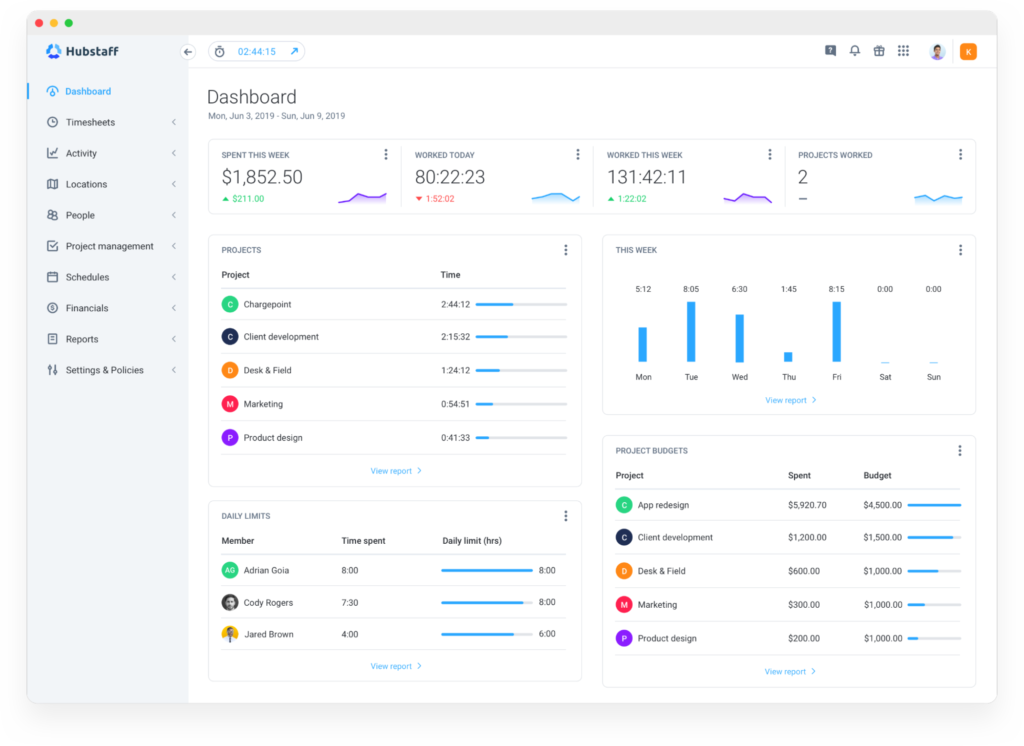
If you’re looking for more visibility, Hubstaff offers 18 different reports that help you increase visibility and optimize your productivity. You can run reports for:
- Time and activity
- Weekly budgets
- Invoice aging

Hubstaff stands out with its proof of work and idle time detection features. With activity levels, website and app usage reports, and optional screenshots, you’ll never have to wonder if work is really getting done. For example, you can see if freelancers are billing you for time while working on other clients. Custom invoicing and integrations with Asana, Wrike, and other project management tools make Hubstaff a great tool for larger teams.
Try our Toggl Track alternative
The simplicity of Toggl Track with added invoicing, scheduling, and more. Free for 14 days. No credit card required.
Is Toggl Track right for you?
Toggl Track is a helpful tool for freelancers. You’ll enjoy the simple setup and anti-surveillance stance if you’re a freelance graphic designer, copywriter, or social media specialist. You can focus on your work with a clean, simple interface that tracks time in the background.
If you’re a business person or team lead, Toggl Track leaves much to be desired. Toggl Track’s team management features are more difficult to use when compared to other time tracking tools, and the lack of productivity data is a big miss for growing teams.
Making assumptions solely based on surveillance tools is not something anyone should condone. But with the right proof of work tools, you can learn more about your team with activity insights and robust reporting tools. Even freelancers benefit from features like screenshots and activity tracking because this data helps create more confidence and trust with clients. With this data, you can help each team member reach new heights.
Toggl Track FAQs
Is Toggl Track really free?
Toggl Track offers a free plan for up to 5 users. It includes basic time tracking and reporting features, and you can add unlimited projects and clients to which your team can track time. If you’re looking for access to subtasks, project templates, or reporting features, you’ll have to upgrade to one of the paid plans.
How much does Toggl Track cost?
The Free plan is free forever. Toggl Track also has a $10 per user/month Starter plan and a $20 per user/month Premium plan. The Starter plan includes access to tasks, templates, and billable rates. You’ll have to upgrade to Premium for project forecasting, scheduled reporting, and team time tracking reminders.
Which is better for automated time tracking: Toggl Track, Hubstaff, or Clockify?
Finding the best time tracking app is subjective. It depends on your needs. Toggl Track is a fantastic tool for freelancers and very small teams with basic needs and a tight budget. Clockify is another free option for teams needing more scheduling features than Toggl Track. Hubstaff offers a blend of time tracking, proof of work, and reporting features that give teams the necessary visibility to grow.
How does reporting work with Toggl Track?
Reporting in Toggl Track is pretty straightforward. Select ‘Reporting’ from the sidebar to access weekly, summary, and detailed reports. From there, you can organize the data into a few different visualizations. If you want to save or schedule reports, upgrade to a paid plan.
How does Toggl Track help with team management?
Toggl Track has more team management features when you upgrade to a paid plan. With the free version, you can track time logged by your entire team. Only paid plans allow you to edit your team’s time entries, mark required fields for time entry, forecast and analyze projects, and centrally control billable rates for your team.
Most popular
The Critical Role of Employee Monitoring and Workplace Security
Why do we need employee monitoring and workplace security? Companies had to adapt fast when the world shifted to remote work...
15 Ways to Use AI in the Workforce
Whether through AI-powered project management, strategic planning, or simply automating simple admin work, we’ve seen a dramatic...
The AI Productivity Panel: Lessons From Leaders on What’s Working (and What’s Not)
When I moderated this AI productivity panel, I expected a solid conversation. What I didn’t expect was the flood of real-world i...
Employee Performance Dashboards: Templates, Tools, and Best Practices
Keeping track of how your team’s really doing can be tricky. Spreadsheets pile up, one-on-ones only tell part of the story, and...





